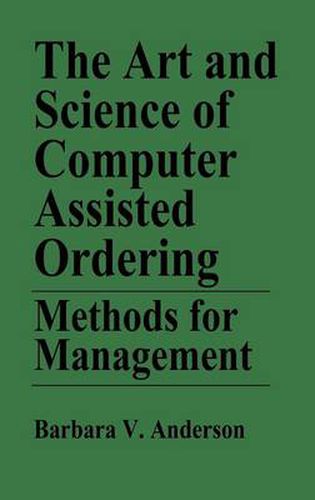Readings Newsletter
Become a Readings Member to make your shopping experience even easier.
Sign in or sign up for free!
You’re not far away from qualifying for FREE standard shipping within Australia
You’ve qualified for FREE standard shipping within Australia
The cart is loading…






CAO is one of the most misunderstood and underutilized weapons available to retailers today. International consultant Barbara Anderson makes clear that in only a limited sense does CAO replace manual ordering. In its full sense it is much more-the optimization of manufacturer, supplier, and retailer distribution to the retail store- based on consumer and store data and corporate policy. Anderson thus provides a framework and checklist for implementing CAO, and understanding of key terminology, solutions to likely problems, and ways to make CAO implementation successful, and in doing so she covers the full spectrum of retailing. A readable, easily grasped, comprehensive, unique book for retailing management and for their colleagues teaching it in colleges and universities.
Anderson points out that CAO is not an off-the-shelf system but an ongoing project, each phase with its own unique set of benefits and cost justification. Retail systems must support a vision where a product may bypass the store on the way to the consumer, or even the distribution center on the way to the stores. Consumers have a wide range of choices, not only of where to shop, but how to shop, and this demands ever greater levels of service. CAO systems help assure that the correct product is available at the store, that it can be located throughout the supply chain, and that it can be moved easily from any location. In CAO, all levels of operation work with real-time information, using decision-making tools that react and learn from new information. Her book thus shows there is no one right system, product, or approach for successful CAO. It’s too big a leap to make in one step but consists of modules and functions that can grow in sophistication over time, and that not all retailers nor all categories within one retailer will use the same methods for forecasting and ordering. She also shows that the distinct separation of replenishment product from planning product is artifically imposed and that the separation of head-quarters from stores is also artificial. Indeed, integration does not mean the integration of separate systems; rather, of business functions themselves. Readers will thus get not only a knowledgeable discussion of what CAO should be, what it is and how it works, but an immediately useful understanding of how to make it work in their own companies.
$9.00 standard shipping within Australia
FREE standard shipping within Australia for orders over $100.00
Express & International shipping calculated at checkout
CAO is one of the most misunderstood and underutilized weapons available to retailers today. International consultant Barbara Anderson makes clear that in only a limited sense does CAO replace manual ordering. In its full sense it is much more-the optimization of manufacturer, supplier, and retailer distribution to the retail store- based on consumer and store data and corporate policy. Anderson thus provides a framework and checklist for implementing CAO, and understanding of key terminology, solutions to likely problems, and ways to make CAO implementation successful, and in doing so she covers the full spectrum of retailing. A readable, easily grasped, comprehensive, unique book for retailing management and for their colleagues teaching it in colleges and universities.
Anderson points out that CAO is not an off-the-shelf system but an ongoing project, each phase with its own unique set of benefits and cost justification. Retail systems must support a vision where a product may bypass the store on the way to the consumer, or even the distribution center on the way to the stores. Consumers have a wide range of choices, not only of where to shop, but how to shop, and this demands ever greater levels of service. CAO systems help assure that the correct product is available at the store, that it can be located throughout the supply chain, and that it can be moved easily from any location. In CAO, all levels of operation work with real-time information, using decision-making tools that react and learn from new information. Her book thus shows there is no one right system, product, or approach for successful CAO. It’s too big a leap to make in one step but consists of modules and functions that can grow in sophistication over time, and that not all retailers nor all categories within one retailer will use the same methods for forecasting and ordering. She also shows that the distinct separation of replenishment product from planning product is artifically imposed and that the separation of head-quarters from stores is also artificial. Indeed, integration does not mean the integration of separate systems; rather, of business functions themselves. Readers will thus get not only a knowledgeable discussion of what CAO should be, what it is and how it works, but an immediately useful understanding of how to make it work in their own companies.